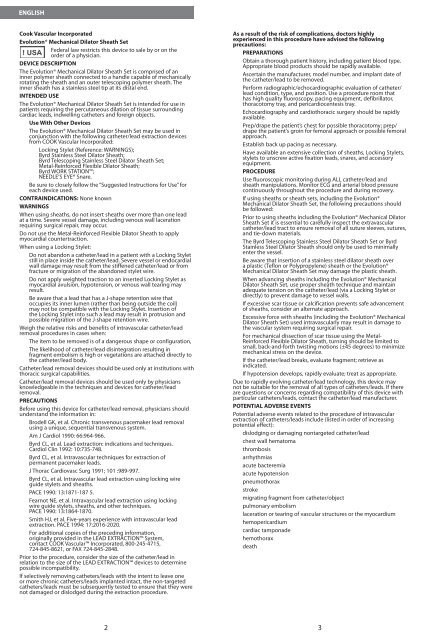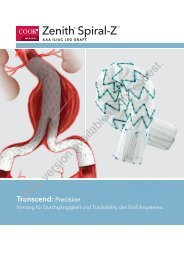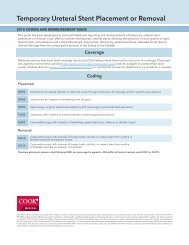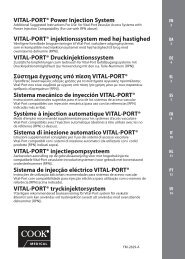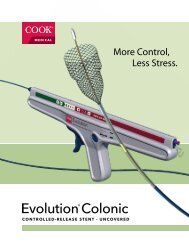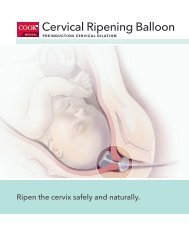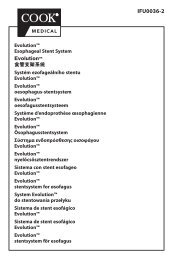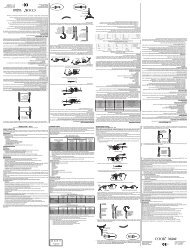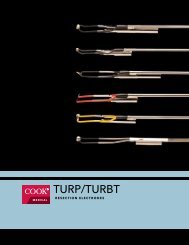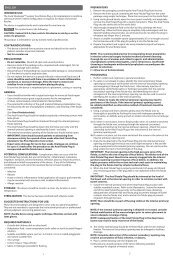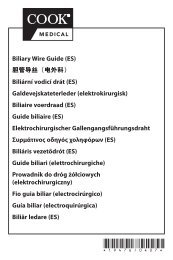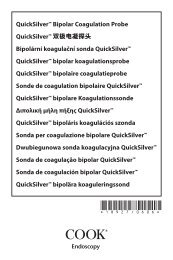FM-2740-C final.indd - Cook Medical
FM-2740-C final.indd - Cook Medical
FM-2740-C final.indd - Cook Medical
You also want an ePaper? Increase the reach of your titles
YUMPU automatically turns print PDFs into web optimized ePapers that Google loves.
ENGLISH<br />
<strong>Cook</strong> Vascular Incorporated<br />
Evolution® Mechanical Dilator Sheath Set<br />
Federal law restricts this device to sale by or on the<br />
order of a physician.<br />
DEVICE DESCRIPTION<br />
The Evolution® Mechanical Dilator Sheath Set is comprised of an<br />
inner polymer sheath connected to a handle capable of mechanically<br />
rotating the sheath and an outer telescoping polymer sheath. The<br />
inner sheath has a stainless steel tip at its distal end.<br />
INTENDED USE<br />
The Evolution® Mechanical Dilator Sheath Set is intended for use in<br />
patients requiring the percutaneous dilation of tissue surrounding<br />
cardiac leads, indwelling catheters and foreign objects.<br />
Use With Other Devices<br />
The Evolution® Mechanical Dilator Sheath Set may be used in<br />
conjunction with the following catheter/lead extraction devices<br />
from COOK Vascular Incorporated:<br />
Locking Stylet (Reference: WARNINGS);<br />
Byrd Stainless Steel Dilator Sheath;<br />
Byrd Telescoping Stainless Steel Dilator Sheath Set;<br />
Metal-Reinforced Flexible Dilator Sheath;<br />
Byrd WORK STATION;<br />
NEEDLE’S EYE® Snare.<br />
Be sure to closely follow the “Suggested Instructions for Use” for<br />
each device used.<br />
CONTRAINDICATIONS: None known<br />
WARNINGS<br />
When using sheaths, do not insert sheaths over more than one lead<br />
at a time. Severe vessel damage, including venous wall laceration<br />
requiring surgical repair, may occur.<br />
Do not use the Metal-Reinforced Flexible Dilator Sheath to apply<br />
myocardial countertraction.<br />
When using a Locking Stylet:<br />
Do not abandon a catheter/lead in a patient with a Locking Stylet<br />
still in place inside the catheter/lead. Severe vessel or endocardial<br />
wall damage may result from the stiffened catheter/lead or from<br />
fracture or migration of the abandoned stylet wire.<br />
Do not apply weighted traction to an inserted Locking Stylet as<br />
myocardial avulsion, hypotension, or venous wall tearing may<br />
result.<br />
Be aware that a lead that has a J-shape retention wire that<br />
occupies its inner lumen (rather than being outside the coil)<br />
may not be compatible with the Locking Stylet. Insertion of<br />
the Locking Stylet into such a lead may result in protrusion and<br />
possible migration of the J-shape retention wire.<br />
Weigh the relative risks and benefits of intravascular catheter/lead<br />
removal procedures in cases when:<br />
The item to be removed is of a dangerous shape or configuration,<br />
The likelihood of catheter/lead disintegration resulting in<br />
fragment embolism is high or vegetations are attached directly to<br />
the catheter/lead body.<br />
Catheter/lead removal devices should be used only at institutions with<br />
thoracic surgical capabilities.<br />
Catheter/lead removal devices should be used only by physicians<br />
knowledgeable in the techniques and devices for catheter/lead<br />
removal.<br />
PRECAUTIONS<br />
Before using this device for catheter/lead removal, physicians should<br />
understand the information in:<br />
Brodell GK, et al. Chronic transvenous pacemaker lead removal<br />
using a unique, sequential transvenous system.<br />
Am J Cardiol 1990: 66:964-966.<br />
Byrd CL, et al. Lead extraction: indications and techniques.<br />
Cardiol Clin 1992: 10:735-748.<br />
Byrd CL, et al. Intravascular techniques for extraction of<br />
permanent pacemaker leads.<br />
J Thorac Cardiovasc Surg 1991; 101 :989-997.<br />
Byrd CL, et al. Intravascular lead extraction using locking wire<br />
guide stylets and sheaths.<br />
PACE 1990: 13:1871-187 5.<br />
Fearnot NE, et al. Intravascular lead extraction using locking<br />
wire guide stylets, sheaths, and other techniques.<br />
PACE 1990: 13:1864-1870.<br />
Smith HJ, et al. Five-years experience with intravascular lead<br />
extraction. PACE 1994: 17:2016-2020.<br />
For additional copies of the preceding information,<br />
originally provided in the LEAD EXTRACTION System,<br />
contact COOK Vascular Incorporated, 800-245-4715,<br />
724-845-8621, or FAX 724-845-2848.<br />
Prior to the procedure, consider the size of the catheter/lead in<br />
relation to the size of the LEAD EXTRACTION devices to determine<br />
possible incompatibility.<br />
If selectively removing catheters/leads with the intent to leave one<br />
or more chronic catheters/leads implanted intact, the non-targeted<br />
catheters/leads must be subsequently tested to ensure that they were<br />
not damaged or dislodged during the extraction procedure.<br />
As a result of the risk of complications, doctors highly<br />
experienced in this procedure have advised the following<br />
precautions:<br />
PREPARATIONS<br />
Obtain a thorough patient history, including patient blood type.<br />
Appropriate blood products should be rapidly available.<br />
Ascertain the manufacturer, model number, and implant date of<br />
the catheter/lead to be removed.<br />
Perform radiographic/echocardiographic evaluation of catheter/<br />
lead condition, type, and position. Use a procedure room that<br />
has high quality fluoroscopy, pacing equipment, defibrillator,<br />
thoracotomy tray, and pericardiocentesis tray.<br />
Echocardiography and cardiothoracic surgery should be rapidly<br />
available.<br />
Prep/drape the patient’s chest for possible thoracotomy; prep/<br />
drape the patient’s groin for femoral approach or possible femoral<br />
approach.<br />
Establish back up pacing as necessary.<br />
Have available an extensive collection of sheaths, Locking Stylets,<br />
stylets to unscrew active fixation leads, snares, and accessory<br />
equipment.<br />
PROCEDURE<br />
Use fluoroscopic monitoring during ALL catheter/lead and<br />
sheath manipulations. Monitor ECG and arterial blood pressure<br />
continuously throughout the procedure and during recovery.<br />
If using sheaths or sheath sets, including the Evolution®<br />
Mechanical Dilator Sheath Set, the following precautions should<br />
be followed:<br />
Prior to using sheaths including the Evolution® Mechanical Dilator<br />
Sheath Set it is essential to carefully inspect the extravascular<br />
catheter/lead tract to ensure removal of all suture sleeves, sutures,<br />
and tie-down materials.<br />
The Byrd Telescoping Stainless Steel Dilator Sheath Set or Byrd<br />
Stainless Steel Dilator Sheath should only be used to minimally<br />
enter the vessel.<br />
Be aware that insertion of a stainless steel dilator sheath over<br />
a plastic (Teflon or Polypropylene) sheath or the Evolution®<br />
Mechanical Dilator Sheath Set may damage the plastic sheath.<br />
When advancing sheaths including the Evolution® Mechanical<br />
Dilator Sheath Set, use proper sheath technique and maintain<br />
adequate tension on the catheter/lead (via a Locking Stylet or<br />
directly) to prevent damage to vessel walls.<br />
If excessive scar tissue or calcification prevents safe advancement<br />
of sheaths, consider an alternate approach.<br />
Excessive force with sheaths (including the Evolution® Mechanical<br />
Dilator Sheath Set) used intravascularly may result in damage to<br />
the vascular system requiring surgical repair.<br />
For mechanical dissection of scar tissue using the Metal-<br />
Reinforced Flexible Dilator Sheath, turning should be limited to<br />
small, back-and-forth twisting motions (±45 degrees) to minimize<br />
mechanical stress on the device.<br />
If the catheter/lead breaks, evaluate fragment; retrieve as<br />
indicated.<br />
If hypotension develops, rapidly evaluate; treat as appropriate.<br />
Due to rapidly evolving catheter/lead technology, this device may<br />
not be suitable for the removal of all types of catheters/leads. If there<br />
are questions or concerns regarding compatibility of this device with<br />
particular catheters/leads, contact the catheter/lead manufacturer.<br />
POTENTIAL ADVERSE EVENTS<br />
Potential adverse events related to the procedure of intravascular<br />
extraction of catheters/leads include (listed in order of increasing<br />
potential effect):<br />
dislodging or damaging nontargeted catheter/lead<br />
chest wall hematoma<br />
thrombosis<br />
arrhythmias<br />
acute bacteremia<br />
acute hypotension<br />
pneumothorax<br />
stroke<br />
migrating fragment from catheter/object<br />
pulmonary embolism<br />
laceration or tearing of vascular structures or the myocardium<br />
hemopericardium<br />
cardiac tamponade<br />
hemothorax<br />
death<br />
2 3


